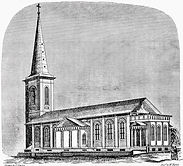SYDNEY
Arrival
Most of the ships bearing the lacemakers to the Australian Colonies in 1848 and early 1849 sailed into Port Jackson and anchored off Sydney town. Some such as those on board Agincourt were sent to further destinations within the colony. However, most of them soon landed and made their way into the town to find work and accommodation.
Sydney in 1848
The waters of Port Jackson, its shores, and the lands behind them provided food and shelter for the Eora peoples for thousands of years. They were fishing in the waters and along the shorelines when 11 small ships sailed into the harbour and dropped anchor off a long point that would much later be called Bennelong Point. The Sydney Cove that the lacemaker immigrants came ashore into was vastly different from that found by the first Europeans to settle there.
Sydney of 1848 was often a surprise for those who arrived from a troubled Europe. Set on undulating hills around a very beautiful harbour, the city had a charm quite unexpected in a former penal colony.
In 1848 the worst of the 1840's depression was over, in fact the glint of gold was beginning to show here and there. Reports of a "show" at Lithgow, Bathurst and Wellington had begun to tickle people's imaginations. The fact that the American gold-rush came before Australia's did not hamper Australia, it only delayed its gold-rush for four years.
Sydney was the gateway to the colony that had several years before, rid itself of the stigma of "Penal Colony". By 1842 Sydney achieved town status and boundary stones marked its extent. Pyrmont Point was growing with busy wharves and docks, housing and streets were being developed in Chippendale and Redfern while in the east, the mansions and estates built along the Darlinghurst ridge were creating an exclusive suburb above Potts Point overlooking Rushcutters Bay.

George Street 1848
The Sydney Morning Herald had a daily circulation of 3,000 carrying advertisements and leading articles and was a "much respected paper". There were nine other papers all circulating less frequently. Both David Jones, a Welsh merchant and Joseph Farmer, a silk mercer, linen draper and haberdasher had set up their stores. Mrs McCathie and Mrs Hordern had also opened stores in Pitt Street, which together with George Street constituted the retail centre of the city. George Street was considered the "Pall Mall" of the colony and the new gas lighting fed from the coal-powered gas works on the shore of Darling Harbour enhanced its amenity. Unfortunately, not many streets were lit with the new gas system.
Sydney was well serviced by "public houses", but the first of the "grand hotels" the Royal, was operating in George Street by 1848. St Andrew's Cathedral was under construction but would not welcome its first worshippers for another 20 years, while the then St Mary’s Cathedral had been serving the Roman Catholic community for decades. The Wesleyans were well served by at least 10 chapels including the impressive Wesleyan Centenary Chapel in York Street. Joseph Fowles in "Sydney In 1848" records splendid theatre evenings in Sydney, even comparing them to Bond Street and Drury Lane. Banking was well under way. Eight banks catered for servicing the financial needs of the people of Sydney and the colony's major export, wool.

Wesleyan Centenary Chapel

Royal Hotel

St James Church
£24 million worth of prime fleece was exported from Sydney each year from a harbour that had been greatly improved by Colonel Barney's Semi Circular Quay providing a deep water berth for the town and had rendered the rise and fall of the tide inconsequential by 1848. The rock used to construct the quay had been quarried from the Argyle Cut, at once providing a through road from one side of the Rocks to the other. The new harbour wall closed in the mouth of the Tank Stream polluted by laundry water and chamber pots, which changed a once freshwater stream into a sewer. Clean water was now available from Busby’s Bore to within Hyde Park and some houses were fed directly from an expanding reticulation system.
While transportation of convicts to the Colony of New South Wales ceased in 1840, eight years later there were still many convicts serving their sentences in Sydney and surrounding districts. The Hyde Park Barracks that had provided accommodation for Sydney’s convicts, from January 1848 provided lodging for immigrant arrivals. Free assisted female migrants from England, Scotland and Ireland were given food, lodging and often counsel from Caroline Chisholm before they found work and lodgings of their own.
By 1843 the "Ferry Queen" was plying between Blues Point and Millers Point following in Billy Blues' tradition. This gave St. Leonards, a township of about 400 people with one church, and the northern farmers, regular transport across the harbour to the city.
Adapted from Claire Loneragan’s article in Tulle No. 6 February 1984
Drawings by Joseph Fowles
Further reading
North Sydney 1788 -1962 by Isadore Brodsky
Highways of History by Geoffrey Scott
Essays from Nineteenth Century Sydney ed. by Max Kelly
The Sydney Scene 1788 -1960 by Alan Birch and D.S. MacMillan
The Memoirs of Obed West A Portrait of early Sydney edited by Edward West Marriott, Barcom Press
Sydney In 1848 by Joseph Fowles available as a free eBook at https://gutenberg.net.au/ebooks06/0600151h.html

Sydney 1848